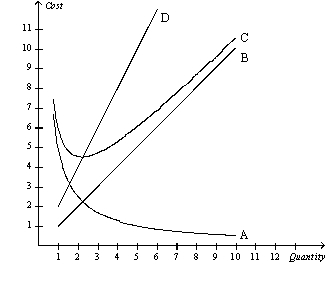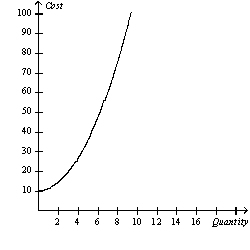Correct Answer

verified
Correct Answer
verified
Multiple Choice
When a firm is experiencing diseconomies of scale,
A) long-run average total cost is minimized.
B) long-run average total cost is greater than long-run marginal cost.
C) long-run average total cost is less than long-run marginal cost.
D) long-run marginal cost is minimized.
Correct Answer

verified
Correct Answer
verified
Multiple Choice
Figure 13-4  -Refer to Figure 13-4.Curve D intersects curve C
-Refer to Figure 13-4.Curve D intersects curve C
A) where the firm maximizes profit.
B) at the minimum of average fixed cost.
C) at the efficient scale.
D) where fixed costs equal variable costs.
Correct Answer

verified
Correct Answer
verified
Multiple Choice
Table 13-7
 -Refer to Table 13-7.What is the variable cost of producing zero widgets?
-Refer to Table 13-7.What is the variable cost of producing zero widgets?
A) $0.00
B) $1.00.
C) $10.00.
D) $10.00
Correct Answer

verified
Correct Answer
verified
Multiple Choice
The total cost to the firm of producing zero units of output is
A) zero in both the short run and the long run.
B) its fixed cost in the short run and zero in the long run.
C) its fixed cost in both the short run and the long run.
D) its variable cost in both the short run and the long run.
Correct Answer

verified
Correct Answer
verified
Multiple Choice
Constant returns to scale occur when a firm's
A) marginal costs are constant as output increases.
B) long-run average total costs are decreasing as output increases.
C) long-run average total costs are increasing as output increases.
D) long-run average total costs do not vary as output increases.
Correct Answer

verified
Correct Answer
verified
Multiple Choice
Figure 13-3  -Refer to Figure 13-3.The graph illustrates a typical total cost curve.Based on its shape,what does the corresponding production function look like?
-Refer to Figure 13-3.The graph illustrates a typical total cost curve.Based on its shape,what does the corresponding production function look like?
A) an upward-sloping curve that increases at an increasing rate
B) an upward-sloping curve that increases at a decreasing rate
C) a downward-sloping curve
D) a horizontal straight line
Correct Answer

verified
Correct Answer
verified
Multiple Choice
Which field of economics studies how the number of firms affects the prices in a market and the efficiency of market outcomes?
A) macro economics
B) industrial organization
C) labor economics
D) monetary economics
Correct Answer

verified
Correct Answer
verified
Multiple Choice
Table 13-13
Consider the following table of long-run total cost for four different firms:
 -Refer to Table 13-13.Which firm has constant returns to scale over the entire range of output?
-Refer to Table 13-13.Which firm has constant returns to scale over the entire range of output?
A) Firm 1
B) Firm 2
C) Firm 3
D) Firm 4
Correct Answer

verified
Correct Answer
verified
Multiple Choice
Scenario 13-5 Samantha has been working for a law firm and earning an annual salary of $80,000.She decides to open her own practice.Her annual expenses will include $15,000 for office rent,$3,000 for equipment rental,$1,000 for supplies,$1,200 for utilities,and a $35,000 salary for a secretary/bookkeeper.Samantha will cover her start-up expenses by cashing in a $20,000 certificate of deposit on which she was earning annual interest of $500. -Refer to Scenario 13-5.According to an economist,which of the following revenue totals will yield her business $50,000 in economic profits?
A) $55,200.
B) $100,200.
C) $132,500.
D) $185,700.
Correct Answer

verified
Correct Answer
verified
Multiple Choice
Table 13-4
Gallo Cork Factory
 -Refer to Table 13-4.Assume Gallo's currently employs 5 workers.What is the marginal product of labor when Gallo's adds a 6th worker?
-Refer to Table 13-4.Assume Gallo's currently employs 5 workers.What is the marginal product of labor when Gallo's adds a 6th worker?
A) 5 corks per hour
B) 15 corks per hour
C) 25 corks per hour
D) 70 corks per hour
Correct Answer

verified
Correct Answer
verified
Multiple Choice
Table 13-10
Jimmy's Gigaplots Factory
 -Refer to Table 13-10.What is the marginal cost of the 4th gigaplot at Jimmy's Gigaplot factory?
-Refer to Table 13-10.What is the marginal cost of the 4th gigaplot at Jimmy's Gigaplot factory?
A) $13
B) $15
C) $19
D) $64
Correct Answer

verified
Correct Answer
verified
Multiple Choice
Table 13-10
Jimmy's Gigaplots Factory
 -Refer to Table 13-10.What is the total cost of producing 7 gigaplots at Jimmy's Gigaplot factory?
-Refer to Table 13-10.What is the total cost of producing 7 gigaplots at Jimmy's Gigaplot factory?
A) $140
B) $150
C) $153
D) $158
Correct Answer

verified
Correct Answer
verified
Multiple Choice
One of the most important properties of cost curves is that
A) for most producers,the average total cost curve never crosses the marginal cost curve.
B) the average fixed cost curve must eventually rise.
C) the average total cost curve first rises,then falls with increased output.
D) the marginal cost curve eventually rises with the quantity of output.
Correct Answer

verified
Correct Answer
verified
Multiple Choice
A firm's opportunity costs of production are equal to its
A) explicit costs only.
B) implicit costs only.
C) explicit costs + implicit costs.
D) explicit costs + implicit costs + total revenue.
Correct Answer

verified
Correct Answer
verified
True/False
The use of specialization to achieve economies of scale is one reason modern societies are as prosperous as they are.
Correct Answer

verified
Correct Answer
verified
Multiple Choice
The amount of money that a wheat farmer could have earned if he had planted barley instead of wheat is
A) an explicit cost.
B) an accounting cost
C) an implicit cost.
D) forgone accounting profit.
Correct Answer

verified
Correct Answer
verified
Multiple Choice
The marginal product of an input in the production process is the increase in
A) total revenue obtained from an additional unit of that input.
B) profit obtained from an additional unit of that input.
C) total revenue obtained from an additional unit of that input .
D) quantity of output obtained from an additional unit of that input.
Correct Answer

verified
Correct Answer
verified
Multiple Choice
Diminishing marginal product suggests that
A) additional units of output become less costly as more output is produced.
B) marginal cost is upward sloping.
C) the firm is at full capacity.
D) adding additional workers will lower total cost.
Correct Answer

verified
Correct Answer
verified
Multiple Choice
Which of the following statements about a production function is correct for a firm that uses labor to produce output?
A) The production function depicts the relationship between the quantity of labor and the quantity of output.
B) The slope of the production function measures marginal product.
C) The slopes of the production function and the total cost curve are inversely related;if one is increasing,the other is decreasing.
D) All of the above are correct.
Correct Answer

verified
Correct Answer
verified
Showing 381 - 400 of 434
Related Exams